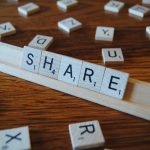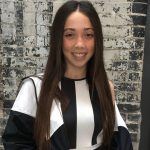Marcia Brands (Netherlands)
Marcia Brands
A personal story

This is the story of Marcia written by her parents, Marion and Walter Brands in November 2019.
Marcia was born at home in Waalre (The Netherlands) on 17 October 1989. Her brother Sander was 15 months old and completely healthy. Marcia had a large head with skull circumference of 40 centimeters at birth and weighed 4200 grams. Her whole body was spotted red, except for one white spot on her belly and the underside of her arms. When she was three days old, the first study was done by the paediatrician, who thought the red spots were all ‘storks bites’.
In December we were referred to the hospital by the ward doctor to make an echo of her head because they thought it was a waterhead. Her head grew fast and the skull circumference was now 47 centimeters. Arrangements were made for a CT scan of the head under anaesthetic, an echo of the abdomen, slides of the skin and radiographs of arms and legs (for length determination).
First (provisional) Diagnosis: Klippel-Trenaunay-Weber
In March 1990, the results of all investigations came: a very rare skin abnormality called Klippel-Trenaunay-Weber syndrome, causing her to have too many blood vessels, especially in the skin. In the scalp she has many more blood vessels, her head started to grow faster (but it was not waterhead).
During the paediatrician’s check-up in May 1990, the red spots had become much paler and the head did not grow so fast anymore. In July, the ward doctor suspected double hip dysplasia and an echo of the hips was made, but the legs were just very flexible.
In October 1990 there was another a check-up by the paediatrician. Because the fontanel was still open, an echo of the head had to be made. Through that echo, you could not see enough and a CT-scan had to be made under anaesthetic. This showed that there was too much cerebrospinal fluid and they wanted to find out why because otherwise the pressure on the brain would become too great. This was to be done at the Radboud hospital in Nijmegen. We got an appointment for an initial investigation on 7 January 1991 which would take about 2 hours, by pediatric neurologist Dr. Rotteveel. An echo of the head was made again and Marcia had to be treated by a physiotherapist because her muscles were too weak. Through the St. Joseph Hospital in Veldhoven, from 21 January 1991 a physiotherapist came to our home to do weekly exercises that we could do with Marcia (Bobath-therapy).
Within two months she then dared to walk around a low table so that she had support from the table and could maintain her balance. She was ‘top-heavy’ because of the big head.
Second diagnosis: Van Lohuizen syndrome or CMTC
On 30 January 1991 there was a consultation with skin physician Dr. Koopman in Nijmegen. He first wanted to conduct more research so we got an appointment for a ‘ bathing session ‘ (In a hot tub!) with pictures of the reaction of the skin on it. Dermatologist Professor Happle was also present.
On 12 February we had a consultation with ophthalmologist Dr. Maas in Nijmegen. No abnormalities of the eyes were detected but, after consultation with a professor, the ophthalmologist advised Marcia to start wearing glasses in order to be able to see better nearby.
On 6 March 1991 we were told the results of all the studies of Dr. Rotteveel. It was not Klippel-Trenaunay-Weber syndrome, but Lohuizen syndrome. That was less bad, but the blood vessels expand very quickly if she gets worried or warm so they wanted to keep an extra eye on her head. With too much pressure, a drain should be placed or medication should be used.
Professor Happle called it: Congenital generalized phlebectasia or cutis marmorata (CMTC). In addition, ventriculomegaly (large brain Chambers) and macrocephaly (large skull circumference) and the left arm is thicker. So she was almost one and a half years old before we knew what kind of abnormality she had.
Toddler-Infancy
Through the pediatrician in Veldhoven we came to the OTOLARYNGOLOGIST because no hearing test had been taken. (Marcia was unable to keep her head upright during the tests in the consultation office). In the Audiological centre in Eindhoven the test could be done and it turned out she could not hear well. Even though she was very young, on 23 September 1991 drum tubes were placed.
On 23 December 1991 there was another check-up in Nijmegen. The echo was okay and the cerebral cavities had not grown. The skull circumference was 58.5 centimeters. Marcia did not walk by herself at the time, that only happened on April 1, 1992 when she was two-and-a-half years old.
She was also allowed to go to the kindergarten for two parts of the day, which she had to get used to it because she was clearly behind in development. When she was four years old she was allowed to go to medical kindergarten Tomteboe in Eindhoven where she was very well supervised. Speech therapy, physiotherapy and occupational therapy had a very beneficial effect on her. She got more confidence and dared more now that she could keep her balance better.
Special education in the Berkenschutse (5-20 years)
From August 1995 to 2009, Marcia went to ‘ De Berkenschutse ‘ in Heeze. This is a school for special education at the Kempenhaeghe Epilepsy Centre and she attended ZMLK-Onderwijs (education for very hard learning children).
An EEG in 1994 did not show any symptoms suspected of epilepsy in Marcia, but because she sometimes has concentration problems we found this school most suitable for her. During school hours, she also received physiotherapy, speech therapy and occupational therapy. The stains faded over the years, but when she becomes angry they flame up again. Her big head is striking and the skull circumference is now 62 inches, which is more than an adult has. In the last two years of the Berkenschutse she ran internships to find a daytime activity. This was: working at ceramics-Atelier De Drie-Ster in Eindhoven and at Zorgkwekerij De Pimpernel in Waalre.
Looking for a place to live
Meanwhile, we were trying to find a place for her where she could live with guidance. Together with other parents, we set up a parent initiative called WoonInitiatief Waalre (WIW). We were able to rent a farm in Waalre and after a renovation, five young people with a disability were able to live there with slight guidance in 2010. Marcia was 20 years old then. Because it was a temporary lease, WIW had to start a new project for the realisation of an apartment building in a new residential area in Waalre. This was realised in 2015.
Unfortunately, Marcia wasn’t going to live there. At the beginning of January 2013, she received epileptic seizures and a three-week hospitalisation followed. Marcia was paralysed on the right side of her body after the seizures. Luckily she recovered and with medication, the epilepsy is under control.
But we had to look for a new place of residence, they now needed 24-hour guidance because of epilepsy.
We found this in Eindhoven on Landgoed Gennep where Marcia has lived since November 2013. She does day activities in the atelier on the estate and on the associated farm Genneperhoeve. On Tuesdays and Thursdays, she still works with great pleasure at Zorgkwekerij De Pimpernel. By now, Marcia is 30 years old (November 2019). We are glad that she has a nice place to live with fun work.
Soon, Marcia has to go to the urologist for examinations, because after a bladder infection she still has pain symptoms and they found kidney stones. In the leaflet of CMTC it says that there may be abnormalities of the kidneys, so we are going to have it examined. It’s nice that this information is available.
Check up
Marcia received care from the HECOVAN (hemangioma and congenital vascular anomaly Nijmegen) department of the Radboud hospital in Nijmegen until her 18th birthday. This workgroup includes specialists in various disciplines and was formed in 1991 at the Academic Hospital in Nijmegen.
An EEG was done on February 21, 1994 and showed no indications of epilepsy. An MRI showed an Arnold Chiari type 1 malformation in the cerebellum. This malformation can cause head and neck pain as well as impairment of balance and coordination. This was investigated because of reduced concentration and awareness.
She finally earned her swimming diploma, class A, in September 2000.
An EEG was taken on May 25th, 2005 because of reoccurring headaches which started in November 2004. The results showed no signs of possible epilepsy.
Tests in Nijmegen were done once every 2 years.
The last visit at the child neurologist, dr. Rotteveel, was on May 16, 2007 because she would turn 18 shortly after that and not be eligible for treatment in the children’s department.
We went to the Academic Hospital in Maastricht for a check-up on April 5th, 2006.
We heard that the dermatologist, dr. van Steensel, who works there, had started a study of the similarities between the symptoms of certain skin abnormalities.
Dr. Vreeburg and dr. Van Steensel started an investigation of the syndrome of Cowden by Marcia, and did this in Maastricht.
June 14, 2007: The diagnosis of Cowden syndrome seemed unlikely, and gave a diagnosis as fitting in the group CMTC syndrome.
Check-ups were done once every 2 years at the polyclinic clinical genetics, Maastricht.
November 18, 2008: Additional genetic diagnostics for the PTEN gen were done. The results indicated a mosaic of a mutation in the PTEN gen.
May 25, 2009: No mutations were found.
There is still no explanation for Marcia’s symptoms that fit in the group of CMTC-M syndromes (The M is an abbreviation for macrocephaly or large head).
January 8, 2013: Epileptic attack, admitted to hospital MMC in Veldhoven. She was paralyzed on her right side but luckily recovered after 3 weeks in the hospital.
Thus, she developed epilepsy in January, 2013, and was given preventative treatment after that.
June 10, 2013: Check-up by dr. Vreeburg at the clinic genodermatology located at the MMC in Veldhoven. Her handicap CMTC-M was changed to M-CAP, macrocephaly with capillary malformation. Further investigation of the PIK3CA gene would be done as this was recently shown, in research, to be one of the causes of M-CAP.
October 15, 2013: No aberrations were found in that gen by Marcia, and further tests will be done.
Marcia didn’t use medications for her epilepsy between 2015 and 2017 because she had not had an attack in the two years before that.
On May 28th, 2017 Marcia had one epileptic attack, and on June 8th, 2017 two. Marcia started again with her medication.
July 3, 2017: A PIK3CA gene mutation was found by Marcia. This mutation can cause various symptoms, most of which are in the CMTC group. M-CAP syndrome is one of them.
Epilepsy often occurs with this mutation. Therefore, Marcia must use anti-epilepsy medication for the rest of her life.
The next check-up by dr. Vreeburg will be in 2020, and we are curious what the outcome will be.
Looking back
If we look back on the period after her birth, which gave a lot of uncertainty about her abnormality, we will always memorise the words of the pediatric neurologist from Nijmegen: “She can still get anything, but it doesn’t have to happen. Enjoy what she can do and try not to worry about it”.
We also want to give this to parents who have just gotten a child with CMTC, try to enjoy it.
Marion and Walter Brands.








